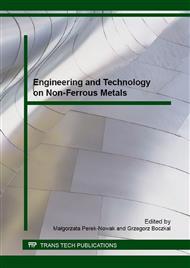[1]
Cook R., Grocock P.G., Thomas P.M., Edmonds D.V., Hunt J.D.: Development of the twin-roll casting process, Journal of Material Processing Technology, 55 (1995) 76-84.
DOI: 10.1016/0924-0136(95)01788-7
Google Scholar
[2]
Ściężor W., Knych T., Mamala A.: Innowacyjna technologia odlewania stopów aluminium metodą twin roll casting, Innowacyjność akademicka akceleratorem rozwoju nauki i przedsiębiorczości, Monografia pod redakcją Janusza Juraszka i Joanny Kurowskiej-Pysz, Bielsko Biała 2012, pp.147-162.
Google Scholar
[3]
Birol Y.: Homogenization of a twin-roll cast thin Al–Mn strip, Journal of Alloys and Compounds, 471 (2009) 122–127.
DOI: 10.1016/j.jallcom.2008.04.005
Google Scholar
[4]
Birol Y.: Response to annealing treatment of a twin-roll cast thin AlFeMnSi strip, Journal of Materials Processing Technology, 209 (2009) 506–510.
DOI: 10.1016/j.jmatprotec.2008.02.019
Google Scholar
[5]
Birol Y.: Response to annealing treatments of twin-roll cast thin Al–Fe–Si strips, Journal of Alloys and Compounds, 458 (2008) 265–270.
DOI: 10.1016/j.jallcom.2007.04.048
Google Scholar
[6]
Birol Y.: Recrystallization of a supersaturated Al–Mn alloy, Scripta Materialia, 59 (2008) 611–614.
DOI: 10.1016/j.scriptamat.2008.05.016
Google Scholar
[7]
Birol Y.: The performance of Al–Ti–C grain refiners in twin-roll casting of aluminium foilstock, Journal of Alloys and Compounds, 430 (2007) 179–187.
DOI: 10.1016/j.jallcom.2006.05.027
Google Scholar
[8]
Kevorkijan V., Smolej A., Dobersek M., Lazeta M., Slacek E., Kosec L, Sarler B., Torkar M., Skrbinek R., Robic A., Kolmanic A., Psenicnik M., Kocevar L., Kegl A., Pleterski J.: Microstructure and formability development in al strip casting for thin-gauge foil production, Materiali In Tehnologije, 39 (2005).
Google Scholar
[9]
Birol Y.: Analysis of macro segregation in twin-roll cast aluminium strips via solidification curves, Journal of Alloys and Compounds, 486 (2009) 168–172.
DOI: 10.1016/j.jallcom.2009.06.167
Google Scholar
[10]
Sanders Jr. R. E., Hollinshead P. A., Simielli E. A.: Industrial Development of Non-Heat Treatable Aluminum Alloys, Materials Forum, 28 (2004) 53-64.
Google Scholar
[11]
Mondolfo L. F.: Metallography of Aluminum Alloys, John Wiley & Sons, USA (1943).
Google Scholar


